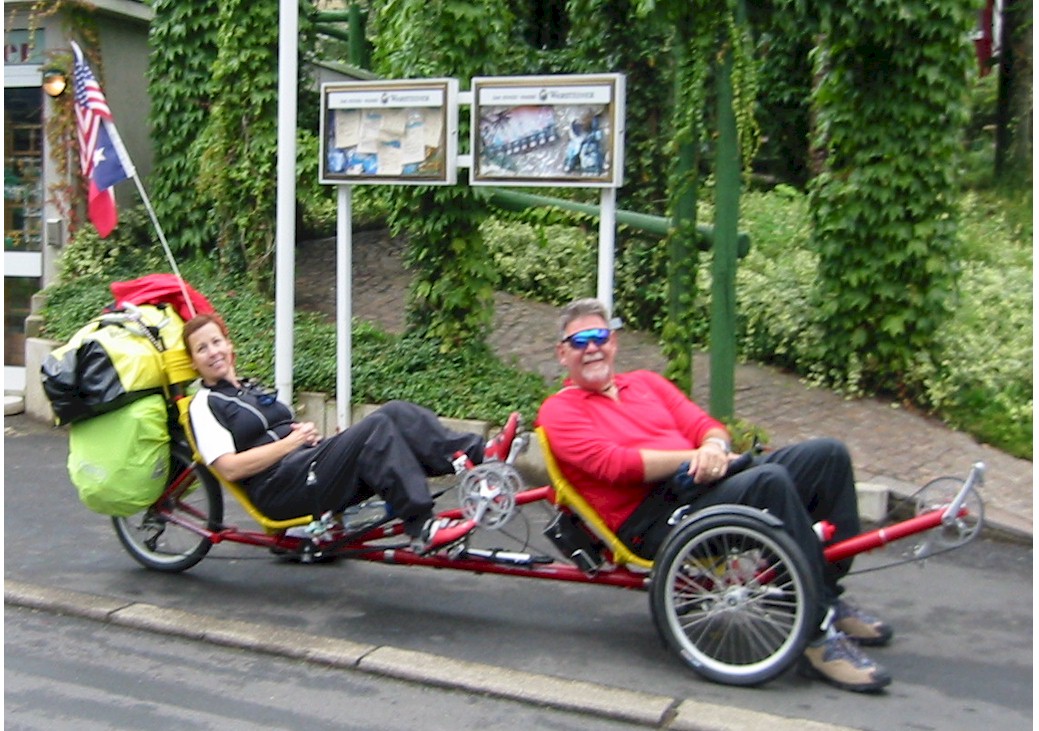Three Wheels, Two Weeks, Three Countries...
Europe 2002

Note: This tour report is still undergoing revision. This is version 1.2, posted September 29, 2002.
When we told our friends that we were planning to go to Germany, Luxemburg, and France on our vacation this year, they said "Great idea!" When we told them that we were going to take our tandem recumbent tricycle, assemble it at the airport, and ride 1000 kilometers with no set schedule or hotel reservations to see those three countries, they said "Are you nuts?"
Though some might question our sanity, past experience with bike touring in France and Holland convinced us that bike touring is the ideal way to see the real Europe.
We started planning the trip almost a year in advance...
First, where would we go? Our criteria included a country with interesting culture, a bike friendly infrastructure, and reasonably flat terrain. After a bit of research on the web (a great site is Bicycle Germany - www.bicyclegermany.com), we decided on a circular route based in in Frankfurt, Germany (based on Judith and Neil Forsyth's book "The Riesling Route"). We would follow the Main and Rhine rivers from Frankfurt to Koblenz, Germany, then the Mosel through Germany to Luxemburg and France where we would connect back to the Rhine by following a canal route to Strasburg, France. The majority of the route would take us through major wine production areas and cultural centers. For a tour itinerary and diary, click here. Click Here to see the Map
We're not the "5 countries in 5 days" type of tourists. We prefer to take a close look at a small region of a country, poke around in the small towns and villages, and just take in the scenery. You won't find us in museums (and we have a strict "one cathedral per day limit"), but we still stumble upon the small things that can tell a lot about a country and it's people.
What time of year? We've found that going to Europe during the so-called "shoulder season" (late spring/early fall) to be less hectic than summer, though the weather can sometimes be a bit dicey. For this trip, we chose mid-September, figuring that the weather would be moderate, crowds less dense, and grapes ready to pick. For once, we got it right - this is probably the only time someone has gone to Europe in September and come back with a tan.
| Language Skills... though English has made great inroads into urban Europe, once you get off the beaten track, things get a bit interesting. If you ask the average Hans or Pierre on the street if he speaks English, the inevitable response is "A little." (though generally, they understand more than they speak). At the minimums, you should be able to go through the basic courtesies (greetings and introductions) and be able to order a beer and ask for directions to the toilet. To get a basic understanding of a language, I use the Pimsleur language system. The introductory courses consist of 8, 30-minute lessons. Normally, I will keep a cd with two lessons in the car and listen while traveling. Once you attain about 80% comprehension, you move on to the next lesson. Obviously, you won't become a world-class linguist with an introductory program, but they can help you get by. |
What about the bike? On past trips, we've rented bikes (and purchased one on our France trip), but after purchasing our first Greenspeed tandem trike, we decided that trikes are the ultimate touring vehicle. In January, we placed an order for a second tandem, this one designed to be disassembled for easy transportation. By May, we had received the new trike and were doing a lot of riding to get ready for the tour.
Because we were going to carry everything on the bike and had to be prepared for all weather and mechanical eventualities, weight and volume of gear would be critical. Again, we relied on the recommendations of others to come up with a list of clothing and equipment. Click here to read about the Gear.









